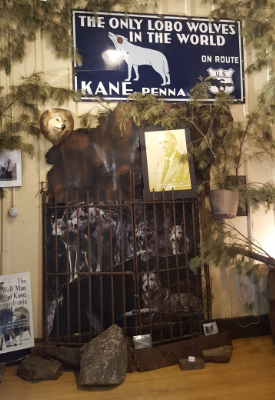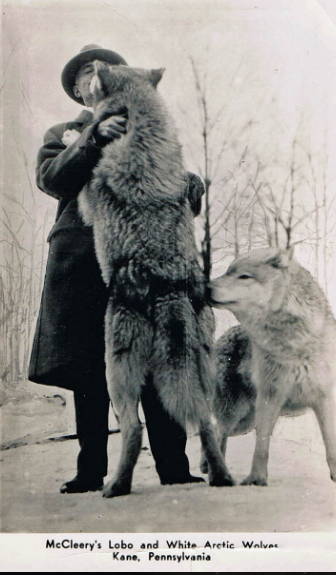The Man Who Saved the Wolves
In the Allegheny National Forest & Surrounds Landscape of the Pennsylvania Wilds, in McKean County, is the McCleery Discovery Center. It’s at 1 S. Fraley St. in Kane, and it holds an extensive collection of items, including wolf pelts and skulls, photos, letters, articles, and other documents.
It’s dedicated to the legacy of a man who is recognized as the “Father of the Endangered Species Movement,” Doctor Edward Heber McCleery.
McCleery was born in Milton, PA, on July 23, 1867, to John and Mary Marr McCleery.
(Photo at right courtesy of the Kane Historic Preservation Society)

He became a physician, the sort of kindly old country doctor you see depicted on a lot of TV shows. He was good at it by all accounts, winning honors and achieving a successful 50-year career. But it was his love of the outdoors and his wolves that made him famous.
In the early years of the 20th century, western livestock was somewhat threatened. Nobody was exactly going to put chickens on the Endangered Species List at the time, but predators were a problem. The issue got so bad that both the American and Canadian governments began to hire bounty hunters. McCleery heard about this and had enough respect for wolves to write to the U.S. Biological Survey, offering to pay for wolf pups to be captured alive and shipped to him.
The program began in 1921, with Dr. McCleery paying for over 20 live wolves through the next decade. He built pens on his property for them, cared for them, and bred them, attempting to keep the subspecies both pure and thriving. The pack on his property wound up growing, the numbers rising as high as 25-40 wolves at any given time.
You can only keep that many wolves in your backyard for just so long without getting known for it, which is exactly what happened to McCleery. He appeared in newsreels. His farm became a popular spot to visit, with people coming from everywhere. In 1929, he was able to move to a new location, midway between Kane and Mount Jewett, along Scenic Route 6. This became a huge tourist attraction, with thousands of people flocking to see the doctor and his pack of Lobo wolves.
(Image at right courtesy of the E.H. McCleery Buffalo Wolf Foundation)

It’s because of all of this that many people consider McCleery to be the first person to save a sub-species of wolf or any animal by himself.
The supply of Lobo wolves had begun to dry up by the mid 1920s. He began to collect other species of wolves, but made sure to keep them separate, not wanting the species to mix genetically.
McCleery eventually sold his wolves and park to a man named Jack Lynch. After McCleery’s death on May 23, 1962, Lynch took care of the wolves in much the same manner as Dr. McCleery. He later moved the wolves to a new site in Washington state. They have since moved to Bridger, Montana, and the E.H. McCleery Buffalo Wolf Foundation now exists there as a private preserve.
The McCleery Discovery Center in Kane opened in 2017 in a restored 1871 Pennsylvania Railroad depot, the same depot where the first wolf pups arrived in 1921. Its mission is to highlight the accomplishments of Dr. McCleery. It holds a collection of letters dating to 1921, journals, photos, and artifacts on display.
“The McCleery Discovery Center was conceived in June 2016,” says Richard Bly, Executive Director of the Kane museum. “The caretaker of the E.H. McCleery Buffalo Wolf Foundation in Bridger, Montana, inquired if the Kane Historic Preservation Society would be interested in receiving the artifacts that had been saved over the years from Dr. McCleery. The Foundation wanted to donate the entire collection to the Kane group to be organized, displayed and preserved for prosperity. Between June and October 2016 the Kane Historic Society had many conversations with the Foundation and shared information.”
Recently, a group of Pennsylvania taxidermists teamed up to preserve a 40-year-old lobo wolf pelt, rehydrating and mounting the pelt of a wolf named Tanya. Born in the 1970s, Tanya lived under Lynch’s supervision. The pelt is now mounted and on display at the center.
Doctor Edward Heber McCleery is buried in Forest Lawn Cemetery in Kane. People still make trips to see the marker and leave flowers. They drop by to give a silent thanks to the man who single handedly saved the Lobo wolves from extinction.

Information in this article was provided by the Kane Historic Preservation Society.


